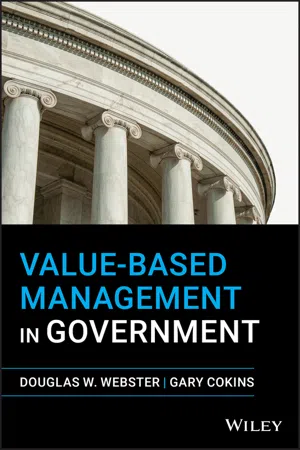
- English
- ePUB (mobile friendly)
- Available on iOS & Android
Value-Based Management in Government
About this book
Provides step-by-step guidance on implementing and using a value-based management system within the government
Countless books on proposed management practices have been written and published over the past century. Some of these have focused on specific management practices for government. In more recent decades, the topics of strategic planning, performance management, cost management and risk management have been extensively covered. However, little has been offered as an approach to integrate these and numerous other management methods and practices in a manner that maximizes the delivery of value to the organization's key stakeholders. A general management framework is presented in this book in a manner particularly applicable to government organizations.
Value-Based Management in Government introduces a new, integrating framework for management practices that optimizes the balancing of results sought; resources supplied and allocated; and risks accepted. These considerations are all balanced for the purpose of delivering maximum stakeholder value. The book offers guidance on how strategic planning, performance management, cost/resource management, and risk management must all be integrated as part of a portfolio management framework across the organization. The book also discusses the role of information technology (IT) in providing data for insights and decision-making, and the importance of organizational change management to implement the needed organizational and behavioral changes.
Beginning by explaining the concept of Value-Based Management for the public sector and government, the text goes on to explore topics such as the evolutionary stages of maturity of management accounting, the benefit of attributes (e.g., value-add versus nonvalue-add) in cost data, predictive planning with expense projections, risk management, and various performance measurements (e.g., key performance indicators [KPIs] ). This authoritative book:
- Discusses a framework for balancing and integrating cost, performance, and risk
- Explains IT systems integration issues related to activity-based cost management (ABC/M)
- Addresses why some ABC/M implementation projects fail to meet expectations
- Describes how quality management efforts can be measured in financial terms
- Explores the wider uses of predictive accounting (e.g., driver-based budgeting, what-if scenario analysis)
- Provides organizational change management insights and recommendations needed to achieve the required changes in management decision-making.
Value-Based Management in Government is an important source of information for leaders, executives, managers, and employee teams working within or with government organizations.
Frequently asked questions
- Essential is ideal for learners and professionals who enjoy exploring a wide range of subjects. Access the Essential Library with 800,000+ trusted titles and best-sellers across business, personal growth, and the humanities. Includes unlimited reading time and Standard Read Aloud voice.
- Complete: Perfect for advanced learners and researchers needing full, unrestricted access. Unlock 1.4M+ books across hundreds of subjects, including academic and specialized titles. The Complete Plan also includes advanced features like Premium Read Aloud and Research Assistant.
Please note we cannot support devices running on iOS 13 and Android 7 or earlier. Learn more about using the app.
Information
PART ONE
Value-Based Management in Government Concepts and Components
CHAPTER ONE
Challenges and Solutions to Address Dissatisfaction of Citizens and Taxpayers
THE US'S ACCOUNTABLE GOVERNMENT INITIATIVE
- Accumulated regulatory burdens
- Structural issues
- Decision-making and processes
- Leadership and culture
- Capabilities and competencies
FROM PERFORMANCE-BASED MANAGEMENT TO VALUE-BASED MANAGEMENT
WHAT DO GOVERNMENTS HOPE TO GAIN FROM VBM?
- Optimizing the use of resources
- Aligning cross-departmental work activities and priorities with collaboration and increased accountability
- Linking the budget and planning processes with an executive team's strategy
- Displaying greater financial visibility and transparency for what outputs cost, and their drivers
- Incorporating risk as an equal tradeoff consideration with results sought and resources committed
- Maximizing overall stakeholder value delivered by the organization
Table of contents
- Cover
- Table of Contents
- About the Authors
- Acknowledgments
- Foreword
- Preface
- PART ONE: Value-Based Management in Government Concepts and Components
- PART TWO: Strategy Management and Governance
- PART THREE: Enterprise Performance Management
- PART FOUR: The Three Rs: Risk, Results, and Resources
- PART FIVE: Management Accounting in Government
- PART SIX: How Information Technology Impacts VBM
- PART SEVEN: Influencing Behavior for VBM
- PART EIGHT: The Future
- Index
- End User License Agreement